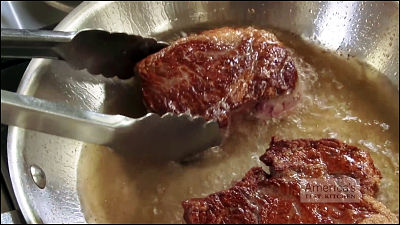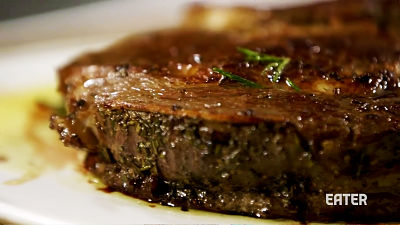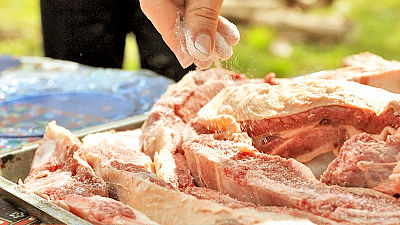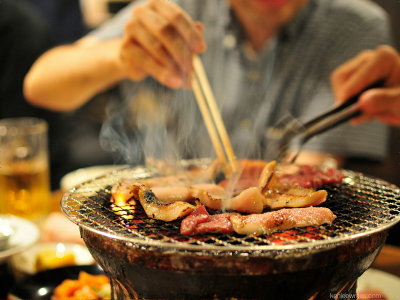A scientific explanation of what it means to 'rest grilled meat' when cooking steaks and other foods

When cooking meat dishes such as steaks, there are cases where the process of 'resting meat' is used, in which the grilled meat is left for a certain period of time without being cut immediately. Generally, it is said that the purpose of resting meat is to 'prevent the meat juices from escaping' and 'to cook it with residual heat', but in recent years, there has been a debate about the necessity of resting meat. Daniel Gritzer, a writer for the cooking web magazine Serious Eats, explains the effects of resting meat from a scientific perspective.
This Major Rule About Cooking Meat Turns out to Be Wrong
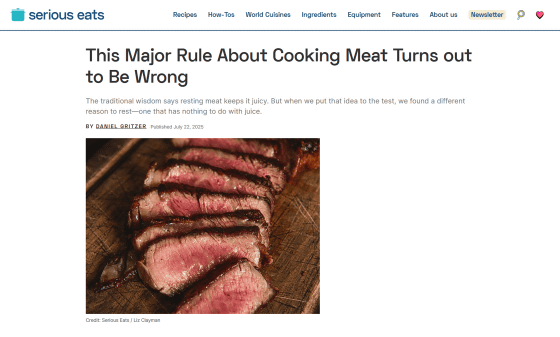
Chefs and experienced culinary researchers have long recommended resting meat before cooking steaks and other foods. According to Gritzer, many proponents of resting meat argue that resting allows the muscle fibers to relax and reabsorb the juices that are pushed to the center during cooking, so they don't spill out when you cut the meat.
In fact, it turns out that meat juices drip out differently if you cut it immediately after removing it from the frying pan or oven than if you let the meat rest. In an article published in 2009 , Kenji, honorary chef and food science expert at Serious Eats, compared how juices drip out when meat is rested and when it is not.
The photo below shows steak meat cooked until the center reached 54°C, then sliced after different rest periods to compare the juices. From the top left, the rest periods are '0 minutes,' '2 minutes 30 seconds,' '5 minutes,' '7 minutes 30 seconds,' '10 minutes,' and '12 minutes 30 seconds.' You can see that the amount of juice released is indeed reduced by the rest periods.
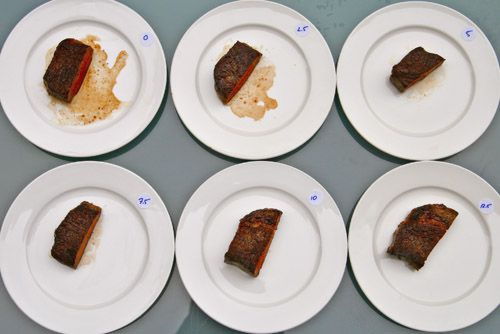
However, an article published in 2013 on the barbecue-related media site AmazingRibs.com argued that resting meat is not a good idea. The article argued that 'the perception of juiciness is extremely complex and cannot be reduced to a single factor such as the rate of moisture loss or retention,' 'spills of meat juice are not wasted but can be recovered by absorbing them while eating the meat,' and 'resting meat causes the crispy exterior to steam, compromising the texture.'
In addition, chef and food scientist Chris Young conducted a comparative experiment in a video published in 2024 using a core thermometer that can measure the internal temperature of meat.
Proof Resting Doesn't Keep Meat Juicy - YouTube
In the video, Young cut steaks that had just been cooked and steaks that had been cooked and rested at a certain internal temperature and measured the loss of juices. The results showed that if the internal temperature was the same, the loss of juices was the same whether the steak was rested or not. In other words, resting meat does not have the effect of 'reabsorbing the juices.'
At first glance, this result seems to contradict the experiment conducted by Kenji, but this is due to the method of the experiment. In Kenji's experiment, all the steaks were cooked to the same internal temperature and then rested for different periods of time. In this case, heat flows from the hotter outside to the inside of the meat, and while the center of the meat is heating up while it is resting, the temperature of the entire meat gradually cools.
Young claims that the reason why resting meat seems to reduce the loss of juices is related to the 'internal temperature of the meat' at the time of cutting. The hotter the meat, the higher the vapor pressure of the moisture inside, making it easier for the juices to overflow when you cut it. On the other hand, as the meat cools, the vapor pressure decreases, making it less likely for the juices to overflow when you cut it.
In other words, the reason why meat juices do not leak out when it is rested is not because the juices are reabsorbed into the muscle fibers, but because the meat as a whole cools down and the vapor pressure of the water decreases. Based on this explanation, it makes sense that in Young's experiment, in which the final internal temperature was kept constant, there was no difference in the amount of juices leaking out whether the meat was rested or not.
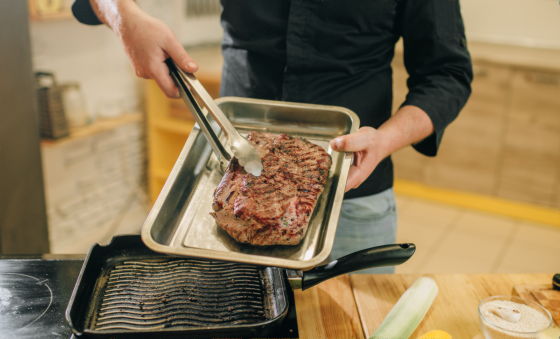
In fact, Gritzer conducted a blind test in which four testers judged which steak was juicier: 'steak meat cut immediately when the internal temperature reached 60°C' and 'steak meat rested after grilling and then cut after residual heat cooking until the internal temperature reached 60°C.' As a result, the testers were only able to judge that the rested meat was juicier in 16 of the 30 tasting rounds. In other words, when factors such as the serving temperature and saltiness are adjusted, resting the meat makes little difference to the juiciness felt by the eater.
On the other hand, Gritzer, who actually cut the meat, reported that he felt that the meat he cut immediately was overcooked, while the meat he let rest felt that the heat was evenly distributed. In other words, there is an advantage to resting meat and slowly cooking it with residual heat, in that the internal temperature of the meat can be stably controlled.
'Removing meat from the pan or oven early to rest is a good idea, but only so the residual heat has time to reach your target internal temperature, and you should track that temperature carefully,' Gritzer said.
Related Posts:
